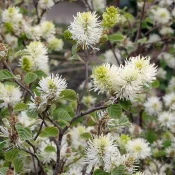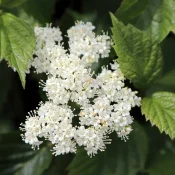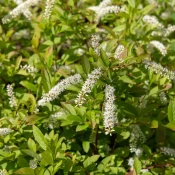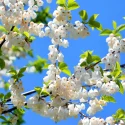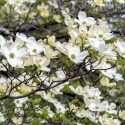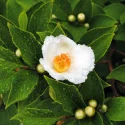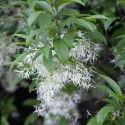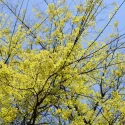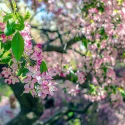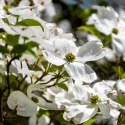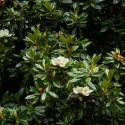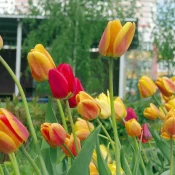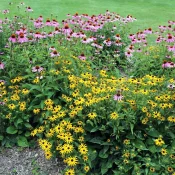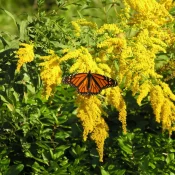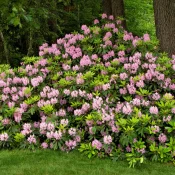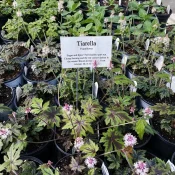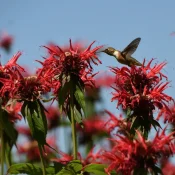Witch-hazel
Native witch-hazels are stunning native shrubs or small trees that flower at strange times: either the end of fall or the dead of winter, depending on the species. The leaves are also beautiful, turning buttery shades of yellow or reddish-orange (depending on species) in the fall. Easy to grow, witch-hazels prefer part-sun spots and can grow up to 20 feet tall. Plant one—or a few!—in a spot that allows you to enjoy their blooms from the comfort of indoors during colder months. Scroll on to meet all three native witch-hazels.
- Full Sun, Part Sun
- Small Tree (15-30')
- Fall flowers, Winter flowers
- Host Plant
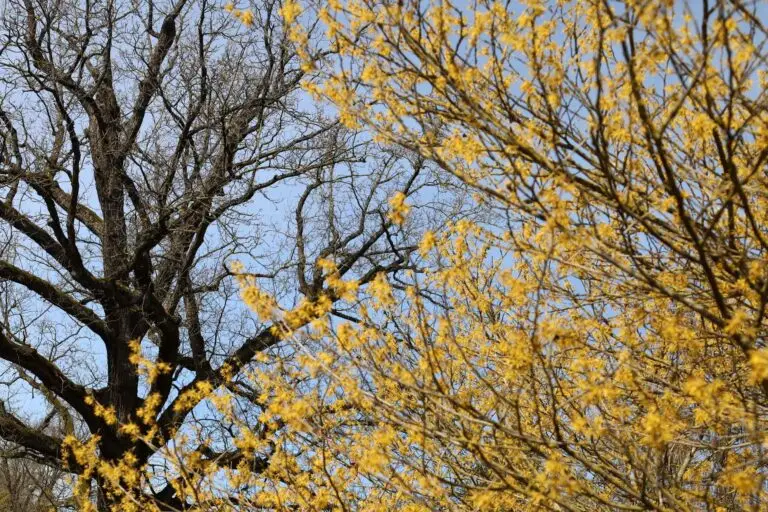
If you’re a beginner gardener looking for a plant that’s both beautiful and easy to grow, native witch-hazel (Hamamelis virginiana or H. vernalis) is a great choice. This native small tree has a lot to offer in looks and resilience, and it can thrive without requiring too much fuss.
In this article, we’ll walk through the four seasons of native witch-hazel, introduce two species, and learn how to plant.
Let’s dig in and meet the non-native and native species…
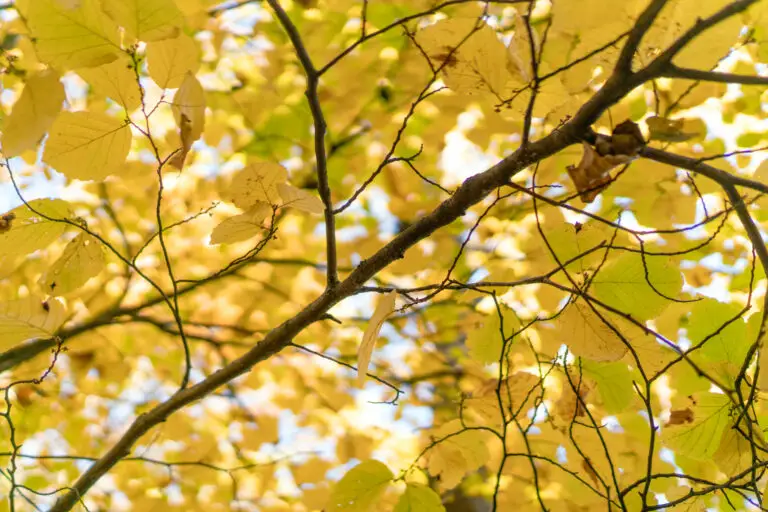
Native witch-hazel vs. non-native witch-hazel
There are five witch-hazel species found globally: three in North America and two in Asia. All five witch-hazels are in the Hamamelis genus. Latin names can look intimidating, but once you see them phonetically, it’s easy to say them out loud. Hamamelis is pronounced: Ha-Ma-Mell-Is.
If you want to plant native, you may need to pay attention to the Latin plant names when buying witch-hazel.
Here’s what’s to look for:
Non-native witch-hazels
Two non-native witch-hazels include:
- Japanese Witch-hazel (Hamamelis japonica) is native to Japan
- Chinese Witch-hazel (Hamamelis mollis) is native to China
Native witch-hazels
Three witch-hazels are native to North America:
- Eastern Witch-hazel (Hamamelis virginiana)
- Ozark or Spring Witch-hazel (Hamamelis vernalis)
- Big-leaf Witch-hazel (Hamamelis ovalis)
FYI: You will probably not find Big-Leaf
Big-leaf Witch Hazel is an extraordinary plant—it was just discovered in 2004! It has a tiny native range nestled alongside a creek in Mississippi, and it’s not available in nurseries (yet).
Because of the Big-leaf’s tiny range, we will focus on the two other native witch-hazel species, which have huge native ranges and are commonly found in plant nurseries. See below to meet them both:
Meet the North American native witch-hazels
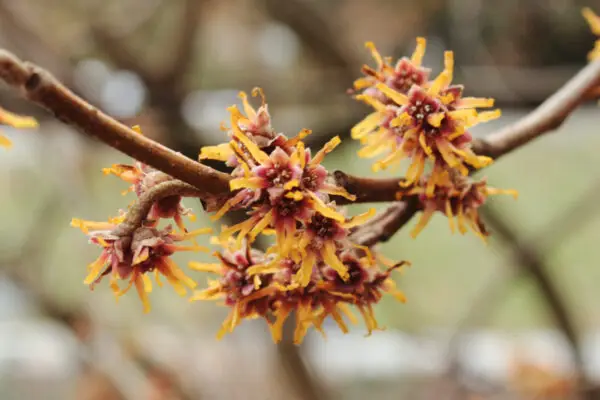
Ozark or Spring Witch-hazel
Hamamelis vernalis
- Blooms in late winter (Feb/Mar)
- Yellow-red flowers
- Leaves turn reddish/orange
- Not as tall: 10 feet
- Native to the Midwest from Missouri to Arkansas, and east to Oklahoma
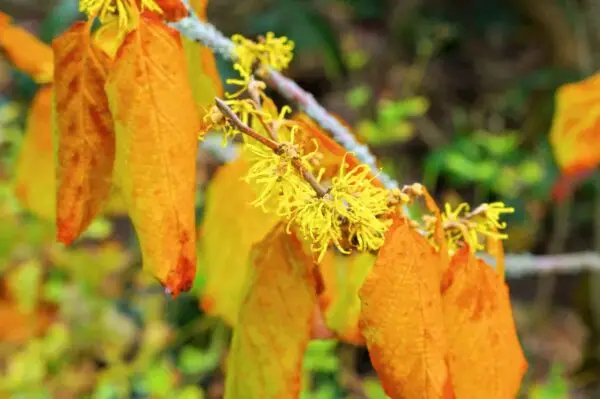
Eastern Witch-hazel
Hamamelis virginiana
- Blooms in late fall (Oct/Nov)
- Yellow flowers
- Leaves turn yellow
- Gets tall: up to 20 feet
- Huge native range from Quebec east to Minnesota and south to Florida
Have you seen another color or another shape of native witch-hazel? That might be a cultivar.
Witch-hazel cultivars
There are many Ozark or Spring Witch-hazel cultivars—or plants that humans have curated. (Here is a short cultivar overview.) These Spring Witch-hazel cultivars offer different leaf and flower colors.
Some Ozark or Spring Witch-hazel cultivars you may encounter include:
- Hamamelis vernalis ‘Amethyst’ has purple flowers in the winter
- Hamamelis vernalis ‘Autumn Embers’ has stunning fall color in the leaves
Strangely, according to Brooklyn Botanic Garden, no cultivars for the Eastern Witch-hazel exist yet!
Cultivar or native, what’s better?
The Plant Native strongly encourages planting true native plants over cultivars. That said, a native witch-hazel cultivar (sometimes called ‘nativar‘) is always better than a non-native witch-hazel. We support more wildlife and contribute more meaningfully to our home environment by planting native.
Native vs. Cultivar
Plant true native plants whenever possible. Cultivars (short for CULTivated VARieties) are selected by humans and often do not offer the same benefits to bugs, birds, and animals that native plants do.
Witch-hazel throughout the seasons
Witch-hazel changes dramatically throughout the seasons, always giving something to enjoy. This type of seasonal change is always a welcome sight, especially compared to boring non-native evergreen shrubs that normally fill landscapes, like boxwoods or yews.
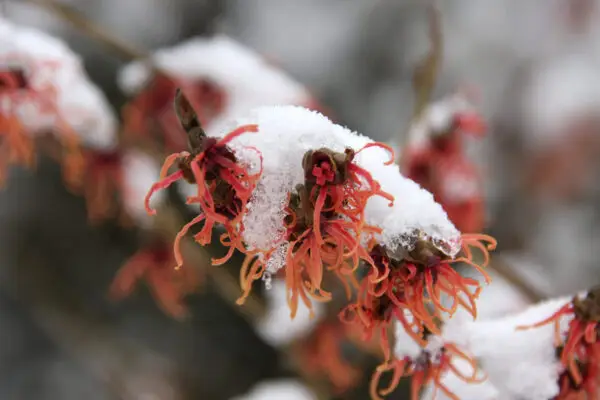
Winter
In January, February, or March, Ozark or Spring Witch-hazels bloom with reddish flowers—even in regions with snow. They are some of the earliest native plants to flower in the Northeast, Mid-Atlantic, and Midwest.
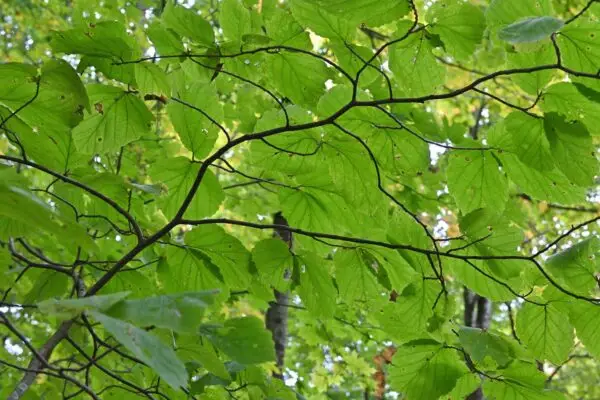
Summer
In the summer, both Witch-hazel species fill their branches with leaves, providing shade.
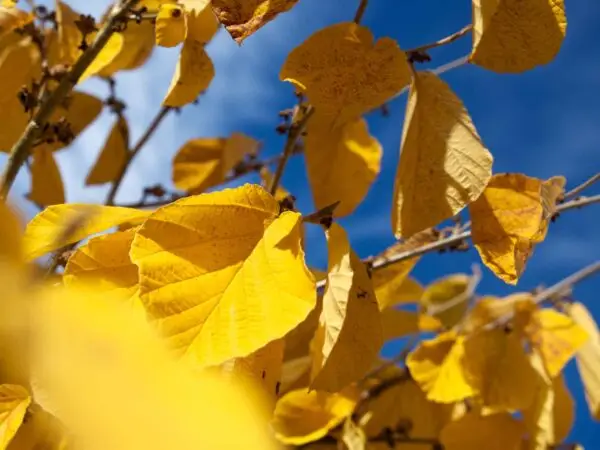
Fall
In the fall, Ozark or Spring Witch-hazels leaves turn warm shades before falling. Their sculptural branches look amazing even without leaves and provide the perfect canvas for their flowers in the late winter.
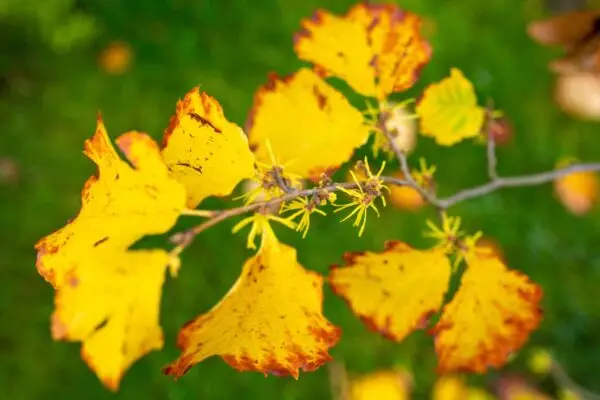
Late fall/early winter
When every other plant has done dormant, Eastern Witch-hazels blossom with yellow flowers. Sometimes, buttery yellow leaves remain alongside. Their flowers smell amazing.
Witch-hazel is a host plant for dozens of butterflies and moths
Native witch-hazels are host plants to 69+ species of butterflies and moths. Without witch-hazels, these native animals would not survive.
What is a host plant?
A host plant is a specific plant that a bug, butterfly, or caterpillar eats, lives on, or lays its eggs on.
Does it remind you of a another shrub or tree? There are a few other native plants that look similar, and often get confused:
Native shrubs similar to witch-hazel
There are a few other natives that look and behave similarly to witch-hazel, with different coloring and heights:
Witch-hazel has a fascinating back story (it helped create a beauty brand we know today!) If you’re interested, here are some FAQs.
FAQs
When do native witch-hazels bloom?
Native Witch-hazel bloom time depends on the species.
- Eastern Witch-hazel (Hamamelis virginiana) blooms in the late fall (Oct/Nov)
- Ozark or Spring Witch-hazel (Hamamelis vernalis)
blooms in the late winter (Jan/Feb)
How do I know which one I’m planting?
To ensure you’re planting the native witch-hazel you want, make sure the name on the label at the nursery matches the Latin name.
Want to be even more sure? Buy one from a native plant nursery. Our Native Plant Nursery List includes 150+, organized by region.
Where did the name witch-hazel come from?
This native plant has nothing to do with witches, witchcraft, or Halloween, and it’s not related to hazel trees, either. This plant’s common name comes from the Anglo-Saxon word wych, which means bendable branch.
Early settlers and possibly Native Americans used witch-hazels bendable branches to detect groundwater and find spots to dig wells. (This type of early stick-finding-water belief is called ‘dowsing‘.)
The second part of its name—hazel—comes from its leaves, which resemble hazelnut tree leaves. But witch-hazels do not produce hazelnuts. 🤷♀️
Early European colonists’ beliefs inspired the names of many native plants
You can tell a lot about the history and beliefs of early European settlers from native plant common names. Some native plants with interesting backstories are…
- Pawpaw trees comes from a mangled version of the Taíno language
- Joe Pye Weed refers to a Native American Mohican leader with a Hollywood-worthy story
- Black-Eyed Susan comes from a weepy 1700s European poem about sailors
If you’d like to read more, we have a fun round-up of strange common names for beautiful native plants.
Do skin products use native witch-hazel?
Witch-hazel’s healing properties have been known for generations
No doubt you’ve seen witch-hazel remedies in drug stores or beauty aisles. Witch-hazel has been known and used for its healing properties by Native Americans for thousands of years.
According to Marjorie Harris’s excellent Botanica North America, “The Osage used the bark to treat sores and ulcers of the skin much as we do today. The Potawatomi and Menominee used the twigs, either placed on hot rocks in a sweat lodge or boiled in water, to soothe aching muscles. The Mohegan used a decoction of the leaves for cuts, bruises, and insect bites.”
All this indigenous knowledge made its way to the European colonists. And then…

Witch-hazel helped start an American beauty icon: Ponds
Back in the 1840s, a man named Theron T. Pond from Utica, New York, began making tea from witch-hazel bark, called it “Pond’s Extract,” and marketed it as a salve for dozens of ailments. The business he started with that first witch-hazel product is still around today: Pond’s.
Do witch-hazel flowers have a smell?
Native witch-hazel flowers have a lovely smell that is almost indescribable. It’s a cross between spicy, sweet gingerbread mixed with an orange. The New York Botanical Garden says, “All I can tell you is that it is clean, inviting, and has a pleasant perfume that isn’t overpowering.”
Want to smell it for yourself? If you live near an arboretum on the eastern side of the United States, take a walk in the winter or late fall to find a native witch-hazel. It’s worth a bundled-up visit. (And then plant one in your yard!)
Some non-native witch-hazels have no smell. The U.S. Forest Service notes,
“Many gardeners have been abandoning the planting of American witchhazel and are now selecting a number of the Asiatic hybrids. However, their flowers have no fragrance.”
Just another reason to plant native!
Why does witch-hazel bloom in the winter, and what pollinators visit it?
Small bees and flies pollinate native witch-hazels. And according to the American Bee Journal…
“In addition to bees, moths, and various flies, the plants attract beetles, parasitic wasps, gnats, leafhoppers, and flower flies. Recent research suggests that while witch hazel is self-fertile on a limited basis, insect pollination enhances seed production.”
However, witch-hazels’ blooming and pollination are still open to discovery:
- Up until the 1970s, they were thought to be wind-pollinated.
- In the 1980s, they were thought to be mainly pollinated by nocturnal moths.
- A 2003 study published in the American Journal of Botany helped debunk both theories and instead found flies and small bees as their main pollination partners.
Even something as seemingly familiar as witch-hazel is still revealing its secrets, proving there’s so much more to learn about the natural world.
A note about their crazy seeds
As Rusty from the Honey Bee Suite says: “Everything about witch hazel flowers is weird.”
This weirdness includes Virginia Witch-Hazel’s seeds: it takes 12 months after being pollinated to turn into seeds. A quick overview of the process:
- Flies and bees pollinate flowers in Oct/Nov
- 5-7 months later, seeds start to mature in May/June
- Seeds ripen in Oct/Nov, a full year after pollination
And then the seeds explode.
No, really! Virginia Witch-hazel seeds will crack open and explode, shooting their seeds as far as possible. If you’re extremely lucky, you can hear these tiny explosions while the plant blooms in the late fall.
The combo of flowers + seeds at the same time is really strange, flower-wise. So strange, it’s where the Latin name comes from. Again, quoting Rusty from Honey Bee Suite:
“The genus name Hamamelis means “together with fruit,” referring to the odd appearance of last year’s fruit with the current year’s flowers.”
What a crazy, beautiful, strange native plant.
Where to plant witch-hazel
Witch-hazel is a plant you want to see in the fall or winter when almost everything in the garden is brown and dormant. Plant them where you can see them while you’re inside. And ideally, enjoying a warm cup of tea or coffee while you admire them.
This advice comes from my own lived experience alongside Carolyn Harstad, who wrote the excellent book “Go Native.” Carolyn’s also offers some helpful advice for Ozark Witch-Hazel pairings:
“Plant H. vernalis where you can enjoy viewing it from inside your warm, cozy house, and give it an underpinning of spring-flowering crocus and daffodils for a spring ‘pick-me-up.”
Thank you, Carolyn, for such a stellar recommendation, perfect for the drab days of early spring! (Note: although daffodils and crocus are not native to North America, they are not generally considered invasive. And who can imagine a spring garden without them?)
Where can I find native witch-hazel to plant?
Sadly, finding specific native plants can sometimes be challenging. Not many conventional plant nurseries stock a wide range of native plants.
To help you find the witch-hazel of your dreams, here are four plant sourcing ideas:
Where can I find seeds and plants?
Finding native plants can be challenging (we partly blame Marie Antoinette.) To make it easier, we’ve assembled four sourcing ideas.
Native Nursery List
300+ native nurseries makes finding one a breeze
Online Native Plant Sellers
We've included 100+ online resources to help
Society Plant Sales
Every state has a native plant society; find yours
Online Communities
Local Facebook groups are a great plant source
What are good witch-hazel pairings?
There are so many native flowers, shrubs, and trees that look stellar next to witch-hazel. To keep the blooming going, pair with native azaleas, Mountain Laurel, and Ninebark alongside Redbud, Sweetbay Magnolia, and Winterberry. You’ll have something to enjoy all year long.
Native witch-hazel is a fantastic addition to any garden, delivering year-round beauty with minimal effort. Whether it’s the memorable spring flowers, the vibrant fall foliage, or the elegant winter structure, this shrub offers something every season. By understanding its simple planting needs, you can easily enjoy the wonders of native witch-hazel for decades. Explore our plant library to find more native favorites. Keep exploring guides to native favorites by visiting our Beginner’s Guide to Coneflowers or the Beginner’s Guide to Native Azaleas. Happy planting!
Sources
- Anderson, G., & Hill, J. (2002). “Many to flower, few to fruit: the reproductive biology of Hamamelis virginiana (Hamamelidaceae).” American Journal of Botany, 89 1, 67-78.
- Burlew, Rusty. “Witch Hazel: The Unusual Feast Bees Need in the Off-Season.” Honey Bee Suite, July 22, 2023.
- Harris, Marjorie. Botanica North America. (2010), 62-63.
- Harstad, Carolyn. Go Native! Gardening with Native Plants and Wildflowers in the Lower Midwest. (1999), 70-71.
- Johnson, Lorraine. A Northerner’s Guide to Native Plants and Pollinators. (2023), 185.
- Nelson, Gil. Best Native Plants for Southern Gardens: A Handbook for Gardeners, Homeowners, and Professionals, (2010).
- Stritch, Larry. “Plant of the Week: Witch Hazel (Hamamelis virginiana L.).” U.S. Forest Service, n.d.
- Uyterhoeven, Sonia. “Witch-Hazels – Plant Talk,” New York Botanical Garden, November 6, 2012.
- “American Witch Hazel.” In Defense of Plants, October 30, 2015.
